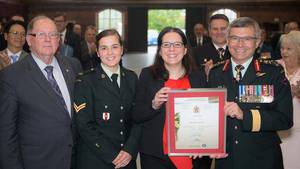The QEII’s Nova Scotia Rehabilitation Centre provides care for people who face physical challenges resulting from injury, illness or aging. The goal is to help them return to their life in the most rewarding way possible. This behind the scenes glimpse focuses on the orthotics and prosthetics department, where people are fitted for new limbs — making their first advances to getting their mobility back. Are you interested in Revitalizing Rehab? Visit QE2Foundation.ca to learn more about how you can help.
 |
 |
| Catherine MacPhail, a prosthetist at the QEII rehab centre, fits six-year-old Drayden Sweeney with a clear diagnostic socket. Drayden was born with an absent shin bone and affected foot. Catherine and Drayden’s friendship dates back to his first birthday. | Deborah Stewart, occupational therapy assistant, is responsible for monitoring the inventory of wheelchairs at the rehab centre, as well as programming those that are motorized. Wheelchairs that aren’t needed are donated or broken down for recycling and repurposing of parts. |
 |
 |
| Dillon MacMillon, a patient with a spinal cord injury, is having custom braces fabricated for him after using a trial pair. While braces aren’t practical for Dillon’s every day use, they’ll be great for exercise purposes and special occasions. Dillon, who will be starting a welding program at NSCC in the fall, says he’ll be the first person in a wheelchair to enroll in the program. | Prosthetists and technicians work together to get the right fit and function for each patient. In this picture, Don Locke selects the thermal plastic that will be used to create the socket. The plastic is heated and is then vacuum-sealed around the plaster mould. The diagnostic socket allows Don to load areas that can tolerate pressure and unload pressure where they cannot. |
 |
 |
| Thomas Black, an orthotist at the QEII’s rehab centre, uses a torch to heat the plastic edges of an ankle/foot orthosis to fine tune the custom fit. | Greg Baker is a third generation orthotic technician, following in the footsteps of his father and grandfather. Here, he presents an old brace that would have been used for a polio patient. While metal and leather braces are still used, plastic braces are increasingly popular. |
 |
 |
| Stuart Grandy, prosthetic technician, adds a print to the plastic that will be used to create a corrective helmet. The helmet is used to treat plagiocephaly, which is a deformation of the bones of the skull that produces a characteristic asymmetrically shaped head. Greg assists Stuart as they drape the heated and now pliable plastic over the mould of the child’s head. The plastic begins to cool within 20 to 30 seconds, so four hands are better than two when quick work and precision are needed. | Jenny Billet, orthotic resident, is sealing a fibreglass cast in order to fill it up with plaster to make a positive mould. Jenny has completed the academic portion of her training and will work under supervision for two years before writing her board exams. |
 |
Sonya Vardy underwent an above knee amputation last year, due to bone tumors and chronic infection. After 24 years of pain and surgeries, the amputation has meant improved mobility and quality of life to Sonya. Here, Sonya is doing a gait analysis with rehabilitation engineer, Kim Parker. The gait-right is a carpet that records a person’s footsteps — almost like foot prints in sand. This gives a quick, objective measure of walking speed, as well as insight into how their weight is distributed. |








